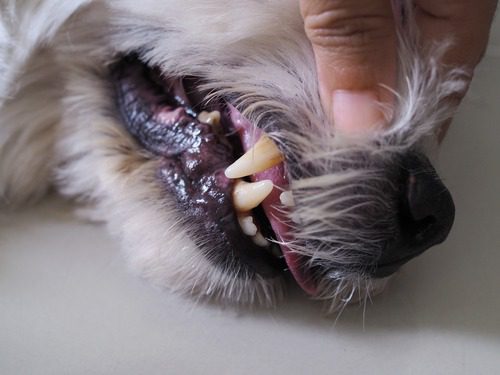My Dog’s Gums are Pale: Is This Normal?

As a pet owner, noticing changes in your dog’s health can be alarming. One of these changes might be pale gums, which can signal a variety of health issues. It’s important to understand what pale gums in dogs could mean and when to seek veterinary care. Let’s explore why your dog’s gums are pale, the potential causes, and what steps you should take.
Understanding Normal Dog Gums
A healthy dog’s gums are typically a bubblegum pink color. This hue indicates good blood circulation and overall well-being. To check your dog’s gums, gently lift their upper lip and examine the gum tissue. Any deviation from this normal pink color can be a sign of an underlying issue. Pale gums can be a symptom of various conditions, some of which may require immediate attention. While it’s not always an emergency, it’s crucial to recognize the potential causes and consult your veterinarian if you notice this change.
Possible Causes of Pale Gums in Dogs
Anemia
Anemia is a common cause of pale gums in dogs. It occurs when there are not enough red blood cells in the bloodstream. These cells are essential for carrying oxygen throughout the body. Anemia can result from several factors, including:
- Blood loss: This could be due to trauma, surgery, or internal bleeding.
- Chronic diseases: Conditions like kidney disease or cancer can lead to anemia.
- Nutritional deficiencies: A lack of essential nutrients such as iron, vitamins, or minerals can contribute to anemia.
Shock
Shock is a serious condition that can cause a dog’s gums to turn pale. It occurs when there is a sudden drop in blood flow, preventing adequate oxygen from reaching tissues and organs. Causes of shock can include trauma that leads to significant blood loss or internal bleeding, severe allergic reactions, and systemic infections.
Blood Parasites
Certain parasites, such as fleas, ticks, and heartworms, can cause anemia by destroying red blood cells. These parasites draw blood from their host, leading to significant blood loss over time. Regular preventive treatments and check-ups can help protect your dog from these parasites.
Poisoning
Ingesting toxic substances can lead to pale gums in dogs. Toxins can cause internal bleeding, damage to red blood cells, or inhibit the production of new red blood cells. Common poisons that can affect dogs include rodenticides, certain plants, and human medications.
Heart Disease
Heart disease can affect the circulation of blood, leading to pale gums. Conditions such as congestive heart failure or heartworm disease can compromise the heart’s ability to pump blood effectively. Regular veterinary check-ups are essential to monitor your dog’s heart health.
What to Do if Your Dog’s Gums are Pale
If you notice that your dog’s gums are pale, it’s important to take the following steps:
- Stay calm: Panicking can make it harder to assess the situation and take appropriate action.
- Check for other symptoms: Look for signs such as lethargy, rapid breathing, weakness, or collapse.
- Contact your veterinarian: Call Dyer Animal Clinic at (219) 865-3737 for advice and to schedule an appointment.
Veterinary Examination
During a veterinary visit, your veterinarian will perform a thorough examination and may recommend diagnostic tests to determine the cause of the pale gums. These tests can include blood tests to check for anemia, infections or other abnormalities, imaging like X-rays or ultrasounds to identify internal bleeding or organ issues, or parasite screening to detect blood parasites or heartworm.
Treatment Options
The treatment for pale gums will depend on the underlying cause. Some potential treatments include blood transfusions for severe anemia or blood loss, medications to treat infections, parasites, or heart conditions, surgery to address internal bleeding or remove tumors, and dietary changes to correct nutritional deficiencies.
Preventing Health Issues in Dogs
- Regular Veterinary Check-Ups: Routine check-ups are crucial for early detection and prevention of health issues that can lead to pale gums. Your veterinarian can monitor your dog’s overall health, perform regular blood tests, and recommend preventive treatments for parasites.
- Proper Nutrition: Feeding your dog a balanced diet rich in essential nutrients supports their overall health. Ensure that their diet includes high-quality proteins, vitamins, and minerals to prevent nutritional deficiencies.
- Parasite Prevention: Regularly administering preventive treatments for fleas, ticks, and heartworms is essential. These parasites can cause significant health problems, including anemia. Discuss the best preventive measures with your veterinarian.
- Monitoring Your Dog’s Health: Keep an eye on your dog’s gums and overall behavior. Any changes in gum color, energy levels, or eating habits should be discussed with your veterinarian. Early intervention can prevent more serious health issues from developing.
Seeking Veterinary Care Promptly
Your pet’s health is important, and addressing changes early can make a significant difference. Regular veterinary visits, proper nutrition, and preventive care are key to maintaining your dog’s health. Pale gums in dogs can indicate a variety of health issues, some of which require immediate attention. By understanding the potential causes and taking prompt action, you can help ensure your dog’s well-being. If you notice that your dog’s gums are pale, contact Dyer Animal Clinic at (219) 865-3737 for a thorough evaluation and appropriate care.
Share This Post
Recent Posts
About Dyer Animal Clinic
We are a place where pets and their people can feel at home. It's a place where wellness is maintained and supported from the time they’re newborns through their golden years.






